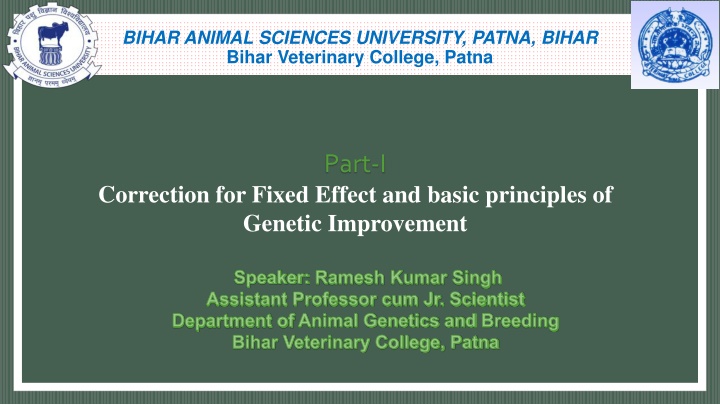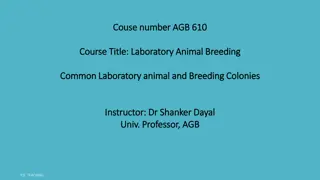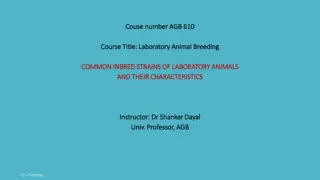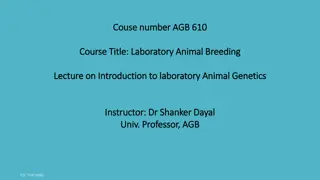
Principles of Genetic Improvement in Animal Sciences at Bihar Animal Sciences University
Explore the correction for fixed effects and the basics of genetic improvement in animal breeding values. Learn about estimating breeding values and the accuracy of EBVs in genetic evaluation at Bihar Veterinary College, Patna.
Download Presentation

Please find below an Image/Link to download the presentation.
The content on the website is provided AS IS for your information and personal use only. It may not be sold, licensed, or shared on other websites without obtaining consent from the author. If you encounter any issues during the download, it is possible that the publisher has removed the file from their server.
You are allowed to download the files provided on this website for personal or commercial use, subject to the condition that they are used lawfully. All files are the property of their respective owners.
The content on the website is provided AS IS for your information and personal use only. It may not be sold, licensed, or shared on other websites without obtaining consent from the author.
E N D
Presentation Transcript
BIHAR ANIMAL SCIENCES UNIVERSITY, PATNA, BIHAR Bihar Veterinary College, Patna Part-I Correction for Fixed Effect and basic principles of Genetic Improvement Speaker: Ramesh Kumar Singh Assistant Professor cum Jr. Scientist Department of Animal Genetics and Breeding Bihar Veterinary College, Patna
Correcting for fixed effects Estimation of breeding values should be based on fair comparisons between individual. Indeed, many environmental factors may mask the animal's genetic abilities. Systematic effects that affect phenotypes are called fixed effects (e.g., age and season at freshening, herds, etc.). For those fixed effects that are observable we can do correction. However, some environmental effects are not attributable to known environmental factors and cannot be corrected for. They are called random environmental effects.
Fixed Fixed effects effects
Accuracy of EBV Accuracy of EBV It is quite impossible to know exactly the true genetic value of a cow. All we have is the estimated breeding value based on phenotypic or genomic information. The accuracy is defined as the correlation between true and estimated breeding value. The main issue for dairy cattle is that usually one cow has one phenotype in one environment. Even if, we can record several performances for production, reproduction and health traits, we still have very few records per cow. Therefore, the accuracy of estimated breeding value based on the own phenotype of a cow is very low. However, as siblings share a proportion of the same genes, it is possible to use their information in estimating breeding values.
To summarize, when we estimate breeding value of a cow: To summarize, when we estimate breeding value of a cow: The knowledge of records from close relatives increases confidence in accuracy of predicting genetic value In general, as heritability increases, the accuracy of predicting genetic value of a cow also increases. The effect of heritability becomes smaller with more information used. The accuracy of parent average depends on the parent EBV accuracy and not on heritability (but note that with low heritability it will be harder for a parent to achieve a certain accuracy).
The table below gives accuracies of predicting value for milk production (h = 0.3) from a cow's records and records of cow's relatives: Number of records on cow No other relatives + 1 record on dam or daugther + her sire's EBV (accuracy = 0.9) 0 0.00 0.25 0.48 1 0.50 0.53 0.63 2 0.57 0.60 0.66 3 0.61 0.63 0.68 6 0.65 0.67 0.71
The table below gives accuracies of predicting value for milk production (h = 0.3) from a cow's records and records of cow's relatives: This table shows that a cow's records are more important than records of many relatives. Records of daughters or dam add little accuracy unless the cow has no records. If the cow has no record, the EBVof her sire is an important indication of her genetic value.
The situation is different when evaluating bulls. With the use of artificial insemination, nearly perfect accuracy of predicting a bull's genetic value can be achieved if enough daughters in many herds are analysed (accuracy of sire's EBV equal to 0.99 with 1000 daughters recorded in different herds). Indeed, having records of daughters in different herds allows a proper estimation of environmental effect and therefore increases accuracy of estimated breeding value of their sire.
Today, genomic test can be done early in an animal life and adds more to the accuracy when there is not much other information available: We just saw how to estimate breeding value and therefore how to rank cows and bulls for interesting traits with more or less accuracy. To obtain genetic improvement only the best must be selected. The extent to which selection will result in genetic improvement depends on the intensity of selection. Info used Heritability 10% Heritability 30% no genomics Genomics no genomics genomics DNA test only 0 0.22 0 0.39 Parents records 0.22 0.31 0.39 0.51 + 20 half siblings 0.35 0.40 0.49 0.58 + own info 0.45 0.48 0.66 0.69 + 20 progeny 0.66 0.67 0.84 0.85 + 100 progeny 0.86 0.86 0.95 0.95














